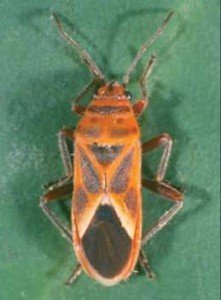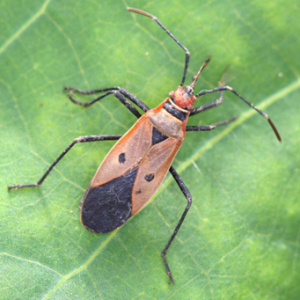Over the past few weeks there have been reports of cotton stainers in cotton crops in Central Queensland and on the Darling Downs. This week we received photographs of ‘stainers’ from CQ which raised the importance of correct identification.
The photograph below is of a species called Graptostethus servus (seed eating bug), which has been collected from crops in CQ and on the Downs. This species of seed eating bug is not known to cause damage to cotton, but is potentially damaging in grain crops such as sorghum, soybean, mungbean and cowpea. However in southern Queensland at least, G. servus populations are usually far too low to be of economic concern.
Little is known about Graptostethus and its potential to damage cotton, so it is prudent to maintain a watching brief on the development of bolls in crops where Graptostethus may be present. Note that this species can swarm with massive aggregations reported in orchards in the NT in the dry season.
Compare this to the pale cotton stainer (below), and you can clearly see the differences in the colour, and the markings. The pale cotton stainer is distinguished by the presence of a dark spot on the forewing, and a dark ‘collar’ behind the head.
Monitoring Pale Cotton Stainer numbers and impact on the crop
Monitor cotton stainer numbers with a beatsheet. A tentative threshold of 3 bugs per metre is proposed. Adults and 3-5th instar nymphs are equally damaging.
Also monitor damage to developing bolls by cutting bolls open and looking for warty growths (in young bolls) or discoloured lint (older bolls). A threshold of 30% damaged bolls is suggested to prevent discounts for discoloured lint.
Pale cotton stainers will feed on both developing and mature cotton bolls, and can affect seed weight, oil content and seed viability. Heavy feeding on bolls less than 2 weeks old may result in shedding. Older bolls will suffer damage to developing seed, and potentially lint. Tightlock can occur around damaged seeds, lint may be discoloured (yellow), and feeding wounds may allow entry of fungi and bacteria that further damage the lint.
Further information on the damage potential and management recommendations for pale cotton stainer can be found in the Cotton Pest Management Guide.


